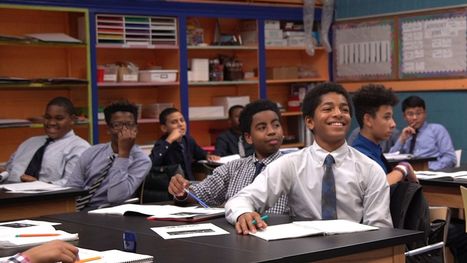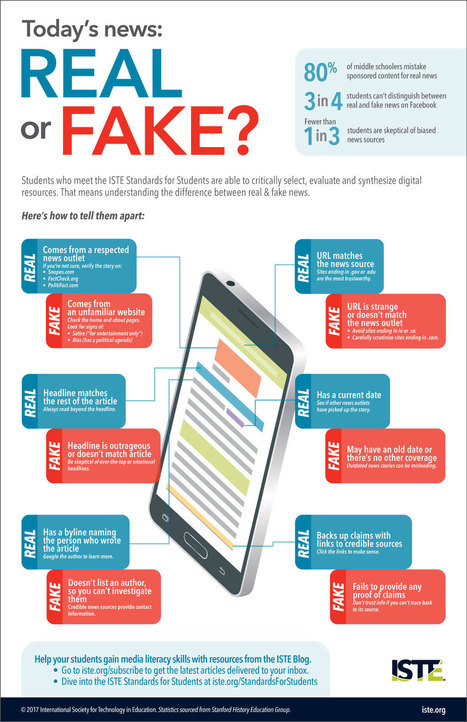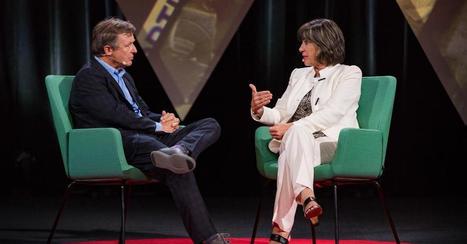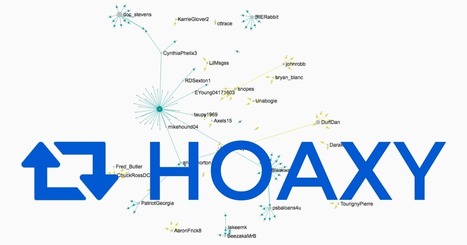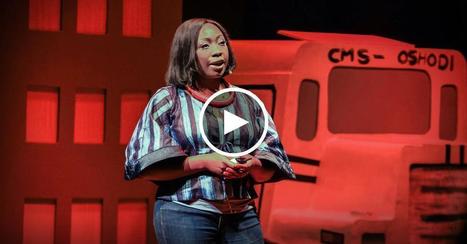 Your new post is loading...
 Your new post is loading...
In a “post-truth” era where people are increasingly influenced by their emotions and beliefs over factual information, fact and fiction can be difficult to distinguish, and fake news can spread rapidly through mainstream media sources and social networks. Moreover, fake news is often meant to do harm, by tricking us into believing a lie or unfairly discrediting a person or political movement.
Given this malicious intent, students must learn to approach news and information with a critical eye in order to identify intentionally misleading sources (although recent studies confirm that this is an uphill battle for both adults and young people). Teachers therefore play a crucial role in ensuring that their students develop the skills to decipher the many streams of information available to them.

|
Scooped by
John Evans
|
Since the 2016 election, a number of independent media organizations and industrious individuals have set out on an ambitious task: to fix the truth. Can a new wave of fact-checking solve the fake news problem?
"What was once the Information Age is rapidly becoming the Disinformation Age, where any information online can be used to support any viewpoint, even those that are patently false. With unrestricted internet access just a few taps on the smartphone away, it is impossible to monitor our students’ online activities constantly. We cannot be on hand to tell them what is right or wrong or true or false. Sometimes, we’re not even sure ourselves. As educators, it falls to us to teach our students a measure of responsibility when they go online. The internet has infiltrated almost every aspect of education. We use it to take attendance, contact parents, look for activities, and do research. Our hope is that our students are using it for research and educational games."
Via Tom D'Amico (@TDOttawa)

|
Scooped by
John Evans
|
Look at this, y'all! It's the cover of a top secret project I've been working on with my friend Darren Hudgins for the last year(ish!)
I'll go into the why and how of this project at some point in the future, but for right now, we really need your help. Part of what we're doing with this book is collecting data on how educators (of all stripes, not just school librarians, but certainly school librarians, too!) are teaching media literacy in the age of "Fake News." We're seeking to find out how/if schools are grappling with this problem, while also identifying what strategies are currently working in the field.
This is where you come in!
To help us, will you please take a few minutes to fill out this brief survey? It would mean the world to us!

|
Scooped by
John Evans
|
Those of us who grew up in a pre-Internet world probably remember passing through grocery store checkout aisles lined with copies of the National Enquirer and other tabloids, with outrageous headlines proclaiming “BAT CHILD FOUND IN CAVE,” “HILLARY CLINTON ADOPTS ALIEN BABY,” or “DOLPHIN GROWS HUMAN ARMS.” Even as children, it was easy to distinguish those fake stories from real news, not just because of the sensational claims but also because of the telltale fonts and the obviously manipulated or fabricated images. Looking back, the division between fake news and authentic journalism seemed quite clear.
In today’s world, however, the line between real and fake seems increasingly blurred and uncertain. False stories are no longer relegated to tabloid publications but instead have infiltrated more mainstream media sources and social networking services. While the ludicrous claims of tabloid fare were meant mostly to entertain, today’s fake news is a more insidious specimen; in many cases, there is a sinister intent to its creation and dissemination. Indeed, the dictionary.com definition of fake news reads: “false news stories, often of a sensational nature, created to be widely shared online for the purpose of generating ad revenue via web traffic or discrediting a public figure, political movement, company, etc” [emphasis added].

|
Scooped by
John Evans
|
Yeah, we all know how much students like to text… So, why not leverage this obsession by taking advantage of a web tool like ifaketext.com, a nifty online generator that mimics the real thing. Not only is it super simple to use, but it’s a visually engaging way to allow students to demonstrate what they know in a unique way. Plus, there’s nothing quite like using one of the most popular forms of social media to grab our students’ interest and attention, right?

|
Scooped by
John Evans
|
All it takes is a single selfie.
From that static image, an algorithm can quickly create a moving, lifelike avatar: a video not recorded, but fabricated from whole cloth by software.
With more time, Pinscreen, the Los Angeles start-up behind the technology, believes its renderings will become so accurate they will defy reality.
"You won't be able to tell," said Hao Li, a leading researcher on computer-generated video at USC who founded Pinscreen in 2015. "With further deep-learning advancements, especially on mobile devices, we'll be able to produce completely photoreal avatars in real time."

|
Scooped by
John Evans
|
New audio and video software will make media manipulations harder to detect. These essential media literacy questions can help.

|
Scooped by
John Evans
|
Which of these statements seems more trustworthy to you?
1) Americans are drowning in a tsunami of ignorance! There is a conspiracy at the highest levels to replace all knowledge with propaganda and disinformation.
2) A recent Stanford University report found that more than 80 percent of middle schoolers didn’t understand that the phrase “sponsored content” meant “advertising.”
For most of the NPR audience, this shouldn’t be a tough question. The first sentence is a florid, mislabeled statement of opinion with an unverifiable, overgeneralized, ideological claim (“conspiracy at the highest levels”).
The second is more measured in tone and limited in scope. And, it has a link that goes straight to the original source: a press release from a reputable university.
But these days, statements of all stripes are bombarding us via broadcast and social media. The trick is classifying them correctly before we swallow them ourselves, much less before we hit “Like,” “Share” or “Retweet.”
And that’s the goal of an educational initiative that will be adopted by 10 universities across the country this coming spring.

|
Scooped by
John Evans
|
Fake news has been on Maggie Farley's mind further back than 2016 when President Trump brought the term into the vernacular.
Farley, a veteran journalist, says we've had fake news forever and that "people have always been trying to manipulate information for their own ends," but she calls what we're seeing now "Fake news with a capital F." In other words, extreme in its ambition for financial gain or political power.
"Before, the biggest concern was, 'Are people being confused by opinion; are people being tricked by spin?' " Now, Farley says, the stakes are much higher.
So one day she says an idea came to her: build a game to test users' ability to detect fake news from real.
Voilà, Factitious. Give it a shot. (And take it from us, it's not as easy as you might think!)

|
Scooped by
John Evans
|
Can the web be your students' best tool in the fight against falsehood?
From viral memes to so-called "fake news," the web is overflowing with information -- true, false, and everything in between. For many kids, this makes the web a challenging place to find credible and reliable sources. So what's the best way to help your students use the web effectively as a fact-checking tool? Here you'll find tips, resources, and practical advice on helping students find credible information online.

|
Scooped by
John Evans
|
Every year Patrick Engleman plays a little trick on his students. The high school chemistry teacher introduces his ninth-graders in suburban Philadelphia to an insidious substance called dihydrogen monoxide. It's "involved in 80 percent of fatal car crashes. It's in every single cancer cell. This stuff, it'll burn you," he tells them.

|
Scooped by
John Evans
|
In the wake of a contentious election season that was influenced by fake news, we examine whether existing technological solutions fix the problem.
|

|
Scooped by
John Evans
|
Factitious is a game for testing your skill at identifying fake and misleading news stories. The game was developed by the American University Game Lab and the American University's School of Communication. I learned about the game last month when Larry Ferlazzo featured it and I have since shared it in a couple of professional development workshops. It was a hit in both workshops in which I shared it with teachers.

|
Scooped by
John Evans
|
Jonathan Jarry's job is to separate sense from nonsense in science, but he never imagined that creating a fake news video would end up being his most effective tool.
Facebook users may be familiar with his latest video for McGill University's Office for Science and Society (OSS) — it has 10 million views and counting.
The video title screams for a click: "This NATURAL TRICK can CURE YOUR CANCER." The opening graphic offers another too-good-to-be-true promise: "This amazing cure for cancer has been known since the 1800s."

|
Scooped by
John Evans
|
You’ve seen them before: Facebook posts designed to grab your attention and stop your scrolling. There are many versions. Some tug at your heartstrings with lines like “Ten cute puppies that will melt your heart” or “Let Suzy know she is still beautiful, even after surgery.” Other versions offer exciting prizes, such as “Like this post and click on the link for a free first-class flight to anywhere in the US!” Unfortunately, many of these posts are created by scammers, striving to collect as many Facebook “likes” as possible.

|
Scooped by
John Evans
|
"A few days ago we shared with you a new Google feature that allows you to easily fact check online content. Today, we are sharing with you 10 good tips that will enable you to critically assess the veracity and credibility of online content (e.g. news stories). These are guidelines Facebook Help Centre provided for it users to help them spot fake news. However, these tips can also apply to any other type of content. Students can use them to evaluate digital content and enhance their critical reading comprehension. We have embedded these tips into the visual below so you can print and share with your students in class. You can also download a PDF copy from this page. Enjoy."

|
Scooped by
John Evans
|
"As the bell rings, students file into class at Maxence Van der Meersch middle school. This morning the kids have a visitor — investigative journalist Thomas Huchon.
Without telling them the topic of his visit, Huchon says he's going to show them a mini-documentary.
The video claims that the CIA spread the AIDS virus in Cuba, and says that was the real reason behind the decades-long U.S. embargo. It was only lifted, the narrator says, so American and French pharmaceutical companies could cash in on an AIDS vaccine developed by Cuban doctors.
The students don't yet know it, but Huchon and his colleagues at video news network Spicee created the video themselves, as part of an experiment after the French terrorist attacks in 2015. They noticed how conspiracy theories against the official version of the attacks were spreading on the Internet, and they wanted to do their own experiment."

|
Scooped by
John Evans
|
FEBRUARY 22, 2018 —From the instant replay that decides a game to the bodycam footage that clinches a conviction, people tend to trust video evidence as an arbiter of truth.
But that faith could soon become quaint, as machine learning is enabling ordinary users to create fabricated videos of just about anyone doing just about anything.
Earlier this month, the popular online forum Reddit shut down r/deepfakes, a subreddit discussion board devoted to using open-source machine-learning tools to insert famous faces into pornographic videos. Observers say this episode represents just one of the many ways that the this technology could fuel social problems, particularly in an age of political polarization. Combating the negative effects of fabricated video will require a shift among both news outlets and news consumers, say experts.
“Misinformation has been prevalent in our politics historically,” says Brendan Nyhan, a political scientist at Dartmouth College in Hanover, N.H., who specializes in political misperceptions. “But it is true that technology can facilitate new forms of rumors and other kinds of misinformation and help them spread more rapidly than ever before.”
So-called fake news has been around long before Macedonian teenagers began enriching themselves by feeding false stories to social media users. In 1782, Benjamin Franklin printed a falsified supplement to the Boston Independent Chronicle maligning Seneca Indians in an attempt to influence public opinion during peace negotiations with Britain.

|
Scooped by
John Evans
|
Do students need to learn about fake news? And more generally, should they learn how news is created and how to evaluate its credibility?
Thousands of schools all over the world believe the answer is yes.

|
Scooped by
John Evans
|
"At a time when misinformation and fake news spread like wildfire online, the critical need for media literacy education has never been more pronounced. The evidence is in the data:
- 80% of middle schoolers mistake sponsored content for real news.
- 3 in 4 students can’t distinguish between real and fake news on Facebook.
- Fewer than 1 in 3 students are skeptical of biased news sources."

|
Scooped by
John Evans
|
Known worldwide for her courage and clarity, Christiane Amanpour has spent the past three decades interviewing business, cultural and political leaders who have shaped history. In conversation with TED Curator Chris Anderson, Amanpour discusses fake news, objectivity in journalism, the leadership vacuum in global politics and more, sharing her wisdom along the way. "Be careful where you get information from," she says. "Unless we are all engaged as global citizens who appreciate the truth, who understand science, empirical evidence and facts, then we are going to be wandering around -- to a potential catastrophe."
"Help users weed out fake news stories and promote critical thinking with this new poster identifying nine tips for evaluating information. With the proliferation of fake news today, these materials show ways users can examine social and news media more carefully to avoid hoaxes and misinformation. Special thanks to author Joanna M. Burkhardt, professor and head librarian at the University of Rhode Island (URI) branch libraries in Providence and Narragansett."
Via GwynethJones

|
Scooped by
John Evans
|
Hoaxy visualizes the spread of claims and related fact checking online. A claim may be a fake news article, hoax, rumor, conspiracy theory, satire, or even an accurate report. Anyone can use Hoaxy to explore how claims spread across social media.

|
Scooped by
John Evans
|
On April 14, 2014, the terrorist organization Boko Haram kidnapped more than 200 schoolgirls from the town of Chibok, Nigeria. Around the world, the crime became epitomized by the slogan #BringBackOurGirls -- but in Nigeria, government officials called the crime a hoax, confusing and delaying efforts to rescue the girls. In this powerful talk, journalist Stephanie Busari points to the Chibok tragedy to explain the deadly danger of fake news and what we can do to stop it.
|




 Your new post is loading...
Your new post is loading...




![The Adventures of Library Girl: Fact VS Fiction: Teaching Critical Thinking Skills in the Age of Fake News [Please take our survey] | iPads, MakerEd and More in Education | Scoop.it](https://img.scoop.it/dbYnK5atJIDOsLbNjiV49zl72eJkfbmt4t8yenImKBVvK0kTmF0xjctABnaLJIm9)


















